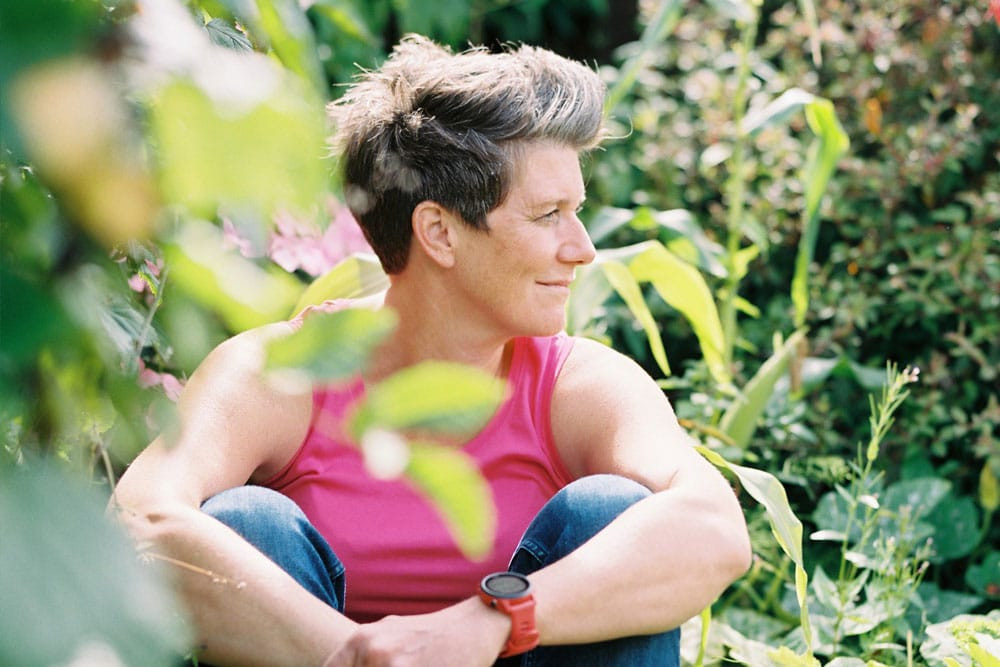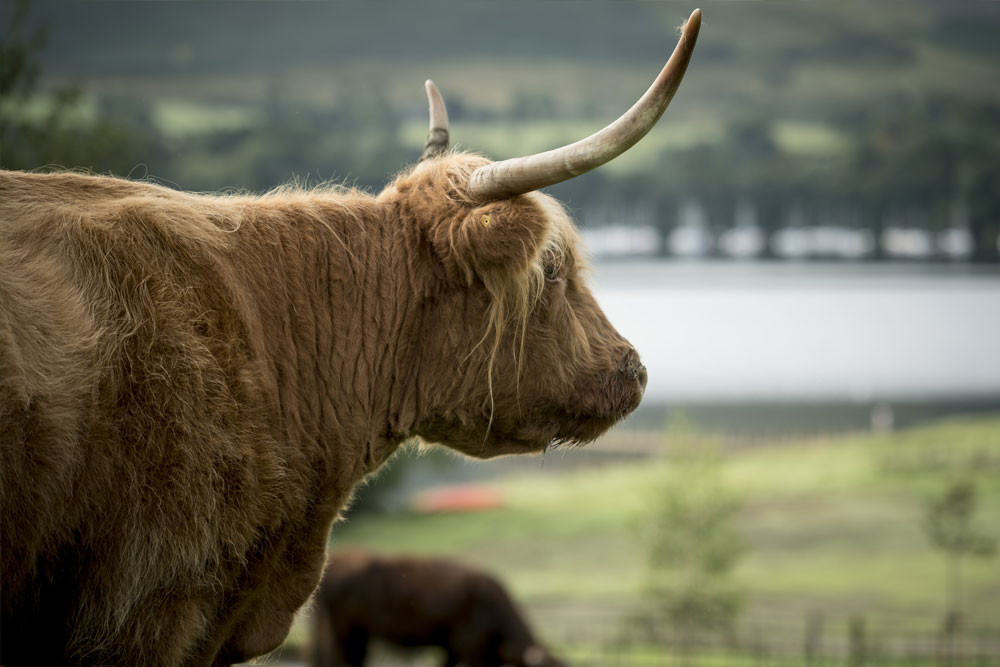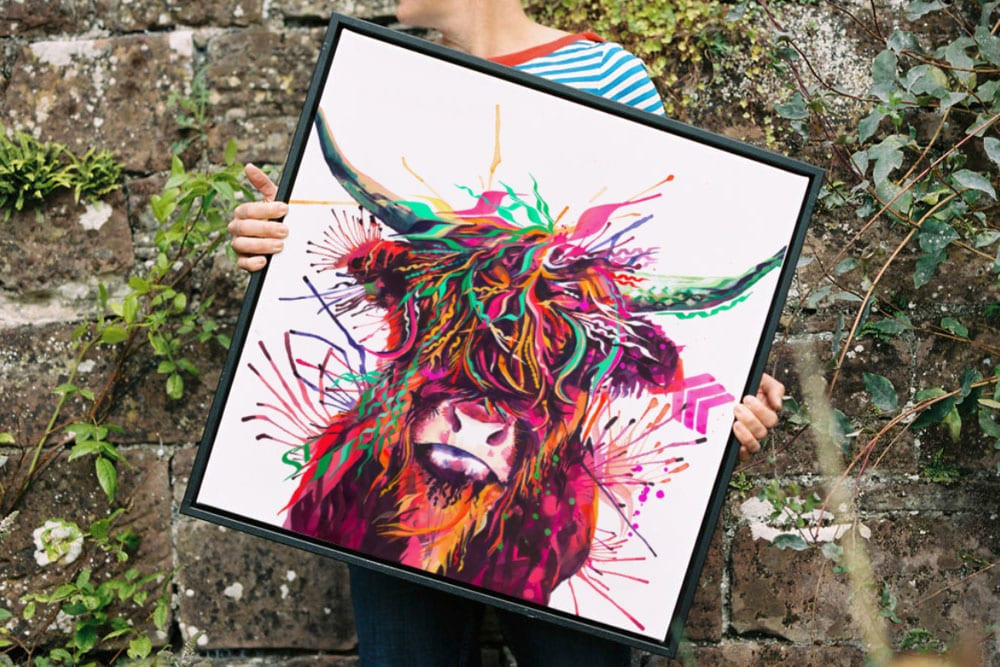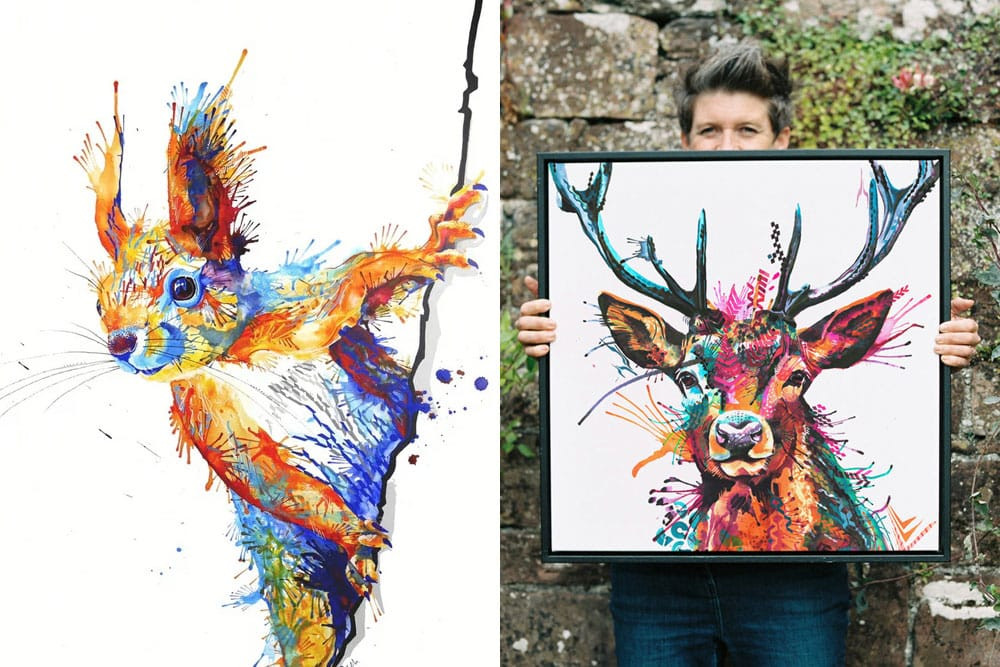Wildlife artist Sarah Taylor
(8 minute read)
Lake District artist Sarah Taylor is passionate about “painting animals for people who love animals”. Fully in touch with her wild side, she’s renowned for her larger-than-life portraits of creatures great and small – who each come ready-christened. From Fern the deer hanging in Rampsbeck Restaurant to Maggie Moo the highland cow in the stairwell, you might have spotted Sarah’s vibrantly-coloured canvases dotted around the walls of Another Place, the Lake.
But how does Sarah achieve her distinctive ink-blown boldness? And what is it about animals that keep her coming back for more? Delving deeper into her practice and life in Cumbria, here are 10 things to know about Sarah and her work:
1. She didn’t take the conventional path to becoming an artist
“People always ask me, ‘How did you become an artist?’ – expecting me to say I studied fine art. But it wasn’t a straightforward route for me. I went from a degree in photography to working in Austria in ski resorts. I was out in the Alps for years – which is unrelated to art in many ways but inspiring in terms of being in the wild.
“When I left Austria, I did a lot of illustration work, and set up my own business printing designs on t-shirts. From that, I ended up working as a graphic designer, and I also worked for an art supplies manufacturer as a product manager, before finally becoming a painter full-time.”

2. She strives to capture the soul of each animal she paints
“The eyes are a really key part of each painting for me. I focus on making the eyes 100% realistic, so it feels like you’re looking into that animal’s soul. I tend to feature the animal head-on, facing the viewer, to bring them even closer.
“I also name all the animals I paint and write a little story about them to bring them to life – an introduction to the different characters for people to read on my website.”
The pieces at Another Place all feature British wildlife – the animals you might see round about the hotel and on the local fells, like hares, stags and highland cows.

3. Nature never fails to inspire her
“Inspiration isn’t always about going to a gallery or following what other artists are doing. I adore being in nature – getting blown about by the wind on a mountain top or splashing around in water. I get energy from being outside in the landscape and seeing wildlife.
“Although the colours I use are bright, they’re inspired by nature. You think – ‘Oh, nature’s just green,’ but actually there’s such a variety of colours that come out through the seasons, and they find their way into my work.”

4. Animals will always be her favourite subject
“I’ve toyed with the idea of painting more people. I’ve done a couple of David Bowie portraits for private commissions, which was fun, but it’s hard to beat that connection of human to animal.
“When you come across a wild animal outside, it’s incredible. Making eye contact with a wild creature, like a deer, it lifts you for the whole day. My instinct is always to think they’re trying to communicate with me, and I wonder what they’re trying to say.”
Galleries can be quite stuffy and unapproachable for people, so I loved the idea you might just stumble across some art on a day out… To have a huge painting in a tree – why not?! It makes you smile. That’s what my art is all about.

5. She exhibited her work along a railway line
“As part of the Cumbrian arts festival, C-Art, I had an outdoor exhibition of my work along the La’al Ratty steam train railway, which runs up the Eskdale Valley.
“Galleries can be quite stuffy and unapproachable for people, so I loved the idea you might just stumble across some art on a day out. I like that element of surprise – the unexpected.
“The paintings were huge – up to about 2m square. There were a couple on station platforms and then lots in places you couldn’t access by foot, where you could only see them from the train. They were mainly positioned in forest, some in rocky areas and several resting in trees. You can’t be precious about art if it’s outside, because nature will do whatever it likes. It makes it all a bit more fun too! To have a huge painting in a tree – why not?! It makes you smile. And that’s what my art is all about really.”

6. She’s a self-confessed water baby
“I absolutely love the water, so Another Place ticks all the boxes for me. It’s active and outdoorsy, and just really cool. I do a lot of wild swimming, and I went for a swim in the lake when I visited the hotel earlier this year. I think the water temperature was about 11 degrees, so it was absolutely freezing but really exhilarating.
“We also had a paddleboarding lesson, which was so fun. I can actually paddleboard properly now rather than just falling in! And we did a swim analysis with Colin Hill which was brilliant.”

7. She painted her pet cat, Frankie, for the first time this year
“Frankie’s like my little studio manager. I painted him recently for my partner’s 40th, so he’s been immortalised in paint. There’s a big difference between painting a pet and a wild animal – plus, it was different because I know Frankie.
“I do a lot of commissions for people, whether it’s their pet dog or an animal they like, and I didn’t realise quite how much the paintings can affect them until I saw my partner’s reaction to Frankie’s portrait. It was quite emotional to see her seeing it for the first time. Frankie will be available to buy on my website soon (the painting that is, not the cat!).”
I do a lot of commissions for people, whether it’s their pet dog or an animal they like, and I didn’t realise quite how much the paintings can affect them until I saw my partner’s reaction to our pet cat Frankie’s portrait…

8. She loves experimenting with new techniques
“Years ago, I used to do landscape painting, and I’d experiment with dribbling ink down the canvas. I started using a hairdryer to move it around, and it evolved from that to blowing the ink with my mouth. If a splash goes where I didn’t intend, that’s ok. The lack of control stops it being too perfect; it introduces more energy.
“I’ve accidentally dropped a whole bottle of ink before and the whole thing’s gone right across the canvas. But it’s never ruined it! If anything, I find those unexpected moments help to bring the painting together and make it unique.”
9. The animals in her paintings live around Another Place
“The pieces at Another Place all feature British wildlife – the animals you might see round about the hotel and on the local fells. Things like hare, deer, stags, badgers, highland cows. There’s a big painting of Maggie Moo the highland cow in the restaurant, then there’s a gallery wall up the stairs with loads of different paintings all together and a lot of the children’s rooms have a selection of smaller prints.
“I’ve painted an otter before, but it’s on my list of animals to revisit – and I believe there are otters down by the lake now. They’ve got great little faces! And then possibly a new red squirrel, which you can also spot around Ullswater. The last time I painted a red squirrel was about six years ago and my style has evolved quite a bit since. It’ll be a different squirrel ‘pose’ – but still cheeky.”

10. Geometric patterns set her work apart
“The geometric patterns in my work originated from doodling. They’re all hand-drawn and all unique, because they’re connected with the animal. When I look at the animal that I’m painting, I may see some shapes in the fur, then I’ll use the patterns to indicate texture and bring out shadows and highlights, rather than just blocking colour.”